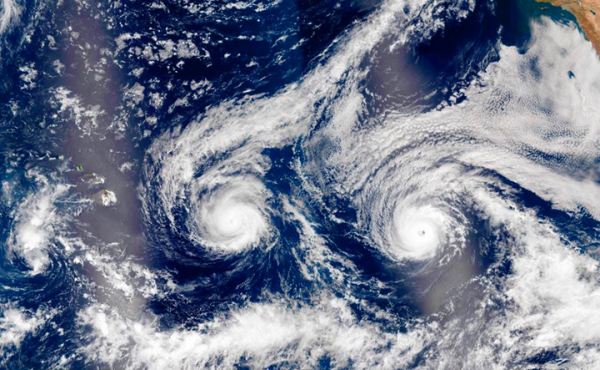人工智能天气预报仍然需要人类的干预

气象学一直都在努力解决大数据的问题。天气具有多变性和混沌性,半个多世纪以来,气象学家一直在试着处理兆兆字节(TB)级别的数据和建模变量做准确的天气预测。到了今天,我们还是在处理数据,数据规模到了千兆兆字节(PB)级别,拜物联网、更多的传感器和集合建模所赐。(图:Getty上的环球历史档案馆/环球图片集团)
业界已经不乏关于人工智能及其应用的好处的讨论,包括约会、营销和社交媒体到太空探索和医学进步。每个行业都受到人工智能工具的影响,包括气象行业。
气象学一直都在努力解决大数据的问题。笔者甚至认为,在大数据这个词成为主流之前,气象学就是大数据的缩影。天气具有多变性和混沌性,半个多世纪以来,气象学家一直在试着处理兆兆字节(TB)级别的数据和建模变量做准确的天气预测。到了今天,我们还是在处理数据,数据规模到了千兆兆字节(PB)级别,拜物联网、更多的传感器和集合建模所赐。写手Ted Alcorn估计,“今天的(天气)模型每天用到约1亿条数据,其复杂程度堪比对人脑或宇宙诞生的模拟。”
但计算能力和人工智能等技术在不断进步,我们现在不仅能够更快、更容易地分析数据,而且还能从历史数据中 “学习”,从而获得更好的态势感知和做出更好的决策。人工智能在气象界能够用于应对几个不同的挑战。其中的一个重点是做出更好的天气预报。
天气预报现在可以更加准确了。时下五天的预测有90%的准确性,与25年前三天预测的准确度相同。短期预测(也就是说以小时为时间跨度的当下预测)则更具挑战性,主要是由于地面的微观变化。DeepMind和埃克塞特大学的科学家们与英国气象局合作,利用人工智能建立了一个当下预测系统,该系统可望克服这些挑战做出更准确的短期预测,包括对重大风暴和洪水的预测。另外一项研究是研究建模的效率以及人工智能如何分析过去的天气模式对未来事件更有效和更准确地预测。
笔者的工作重点(以及我特别感兴趣的人工智能领域)是人工智能在预测来自天气事件的潜在影响方面的应用,相对于天气本身而言,更多的涉及到天气所产生的结果。
例如,公共事业部门利用人工智能预测可能出现的停电。一个特定的公用事业地点或地区的历史停电数据收集了以后可以允许计算机根据预测的天气状况生成对未来需求的预测。这些历史数据涵括了基础设施应对过去的风暴的知识,包括学习加固网络的差异,实现个别基础设施组件的年龄和维护的做法。这些数据集可以生成未来可能到来的风暴导致的停电基线数据。市政区管理层次上也可以采用同样的方法。我们对于城市的基础设施、地形和疏散路线等变量以及历史气象数据的了解,可以帮助城市更好地洞察潜在的影响领域和公共或基础设施安全的风险。
而且,在我们谈论先进的技术和洞察力的同时,笔者认为人的因素在这个过程中仍然至关重要。最近《连线》杂志的一篇文章提到一些研究结果,这些研究发现人类预报员的预测比人工智能的预测更准确。
另一个需要人为干预的领域是风险沟通者的增长需求。风险沟通者是一群特殊的气象学家,他们在预测的基础上更进了一步,将风险或影响传达给企业、市政当局或公众。我听到过一些评论指,在人工智能更值得信赖后就可以简单地切换天气偏好按需求获得准确、有意义的天气数据。我们将拥有逐步改善的数据和预测,这一点我同意,但我相信这也将增加对人类专家的需求,以达到评估、解释和沟通数据(以及风险和影响)的目的,所用到的方式是有意义的,可以帮助那些必须做出灵活、明智决定以保护人民、基础设施和企业资产的人。更大的问题并不是人类预测还是人工智能预测,而是气象学家如何利用改进的人工智能帮助决策者为他们的利益相关者做出最佳决定。
好文章,需要你的鼓励
CoreWeave LOTA技术实现对象数据高速全球传输
CoreWeave发布AI对象存储服务,采用本地对象传输加速器(LOTA)技术,可在全球范围内高速传输对象数据,无出口费用或请求交易分层费用。该技术通过智能代理在每个GPU节点上加速数据传输,提供高达每GPU 7 GBps的吞吐量,可扩展至数十万个GPU。服务采用三层自动定价模式,为客户的AI工作负载降低超过75%的存储成本。
IDEA研究院等机构联手打造智能AI助手:让机器像人类一样思考和学习的突破性技术
IDEA研究院等机构联合开发了ToG-3智能推理系统,通过多智能体协作和双重进化机制,让AI能像人类专家团队一样动态思考和学习。该系统在复杂推理任务上表现优异,能用较小模型达到卓越性能,为AI技术的普及应用开辟了新路径,在教育、医疗、商业决策等领域具有广阔应用前景。
谷歌DeepMind与CFS合作开发核聚变等离子体AI控制系统
谷歌DeepMind与核聚变初创公司CFS合作,运用先进AI模型帮助管理和改进即将发布的Sparc反应堆。DeepMind开发了名为Torax的专用软件来模拟等离子体,结合强化学习等AI技术寻找最佳核聚变控制方式。核聚变被视为清洁能源的圣杯,可提供几乎无限的零碳排放能源。谷歌已投资CFS并承诺购买其200兆瓦电力。
AI训练新突破:上海AI实验室让大模型自己当老师,推理和判断能力同步飞跃
上海人工智能实验室提出SPARK框架,创新性地让AI模型在学习推理的同时学会自我评判,通过回收训练数据建立策略与奖励的协同进化机制。实验显示,该方法在数学推理、奖励评判和通用能力上分别提升9.7%、12.1%和1.5%,且训练成本仅为传统方法的一半,展现出强大的泛化能力和自我反思能力。
CoreWeave LOTA技术实现对象数据高速全球传输
谷歌DeepMind与CFS合作开发核聚变等离子体AI控制系统
微软为Windows 11推出全新Copilot自动化功能
苹果研究人员探索AI如何预测Bug、编写测试并修复代码
刚果称全球最大水电站可为AI数据中心供电
HPE Alletra存储业务获得战略重点关注
谷歌DeepMind与核聚变初创公司合作的真实原因
Omdia预测:超大规模云市场销售额2030年将达1630亿美元
Oracle全面押注AI,用户仍在摸索应用路径
Aramex与AWS携手推进全球物流数字化转型
Oracle增强AI智能体平台与微软谷歌竞争
开源GZDoom社区因AI代码使用分裂
最热门的 AI 模型:它们的功能和使用方法
这款古怪的 AI 智能手机可以创建你的数字分身
Faireez 获 750 万美元融资,为租赁市场提供 AI 驱动的酒店式管家服务
Broadcom 大获全胜:70% 大型 VMware 客户购买其最全面解决方案
Peer 获得1050万美元元宇宙引擎投资,推出3D个人星球功能
获 3000 万美元融资,Crogl 发布面向安全分析师的全新 AI "钢铁侠战衣"
Turing 获得 1.11 亿美元融资,估值达到 22 亿美元,为 OpenAI 等大语言模型公司提供关键代码支持
Tavus 推出系列 AI 模型,实现实时人脸交互技术突破
Welevel 获得 570 万美元融资,革新程序化游戏开发
AI 驱动的卓越运营:企业如何通过人人可及的流程智能提升成功







